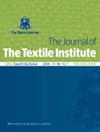Antibacterial PVP/cinnamon essential oil nanofibers by emulsion electrospinning
IF 1.5
4区 工程技术
Q2 MATERIALS SCIENCE, TEXTILES
引用次数: 32
Abstract
Abstract This study presents the production of antibacterial Polyvinylpyrrolidone/cinnamon essential oil (PVP/CEO) nanofibers by oil-in-water emulsion electrospinning, with solution properties such as GC-MS, conductivity, viscosity, and characterization using SEM (fiber morphology), FT-IR (chemical structure), UV-vis (release properties of CEO). In addition, the antimicrobial properties of the nanofibers are also investigated by the disc diffusion method (antimicrobial properties) using Staphylococcus aureus, Escherichia coli, Pseudomonas aeruginosa, and Candida albicans. According to the results, the viscosity values increase with the addition of surfactant and with increased CEO concentration, but the conductivity increases until PVP1 then has decrease tendency. As concerns the fiber properties, the average fiber diameter increased with surfactant addition and CEO concentration except for PVP4. Also, the spinnability and fiber smoothness were enhanced significantly with surfactant and CEO. FT-IR analysis results verified the existence of CEO and PVP in the structure of the nanofibers. The absorbance values increased with the CEO concentration except for PVP4. Lastly, the antimicrobial results showed that 2, 3, and 4 wt% CEO concentration values are suitable for good antibacterial properties, while there is no zone formation with 1 wt% CEO concentration of PVP nanofibers. It is another important result that the antibacterial activity increases with the size of the nanofibrous material.乳液静电纺丝制备抗菌PVP/肉桂精油纳米纤维
摘要本研究采用水包油乳液静电纺丝法制备了抗菌聚乙烯吡咯烷酮/肉桂精油(PVP/CEO)纳米纤维,并对其进行了GC-MS、电导率、粘度等溶液性质的表征,并利用SEM(纤维形态)、FT-IR(化学结构)、UV-vis (CEO的释放性能)等进行了表征。此外,利用金黄色葡萄球菌、大肠杆菌、铜绿假单胞菌和白色念珠菌,通过圆盘扩散法(抗菌性能)研究了纳米纤维的抗菌性能。结果表明,黏度随表面活性剂的加入和CEO浓度的增加而增加,而电导率则不断增加,直至PVP1出现下降趋势。在纤维性能方面,除PVP4外,平均纤维直径随表面活性剂添加量和CEO浓度的增加而增加。表面活性剂和CEO的加入也显著提高了纤维的可纺性和光滑度。FT-IR分析结果证实了纳米纤维结构中存在CEO和PVP。除PVP4外,吸光度随CEO浓度的增加而增加。最后,抗菌结果表明,2、3、4 wt%的CEO浓度值对PVP纳米纤维具有较好的抗菌性能,而1 wt% CEO浓度的PVP纳米纤维没有形成带。抗菌活性随纳米纤维材料尺寸的增加而增加,这是另一个重要的结果。
本文章由计算机程序翻译,如有差异,请以英文原文为准。
求助全文
约1分钟内获得全文
求助全文
来源期刊

Journal of the Textile Institute
工程技术-材料科学:纺织
CiteScore
4.20
自引率
5.90%
发文量
149
审稿时长
1.0 months
期刊介绍:
The Journal of The Textile Institute welcomes papers concerning research and innovation, reflecting the professional interests of the Textile Institute in science, engineering, economics, management and design related to the textile industry and the use of fibres in consumer and engineering applications. Papers may encompass anything in the range of textile activities, from fibre production through textile processes and machines, to the design, marketing and use of products. Papers may also report fundamental theoretical or experimental investigations, including materials science topics in nanotechnology and smart materials, practical or commercial industrial studies and may relate to technical, economic, aesthetic, social or historical aspects of textiles and the textile industry.
All published research articles in The Journal of The Textile Institute have undergone rigorous peer review, based on initial editor screening and anonymized refereeing by two expert referees.
 求助内容:
求助内容: 应助结果提醒方式:
应助结果提醒方式:


